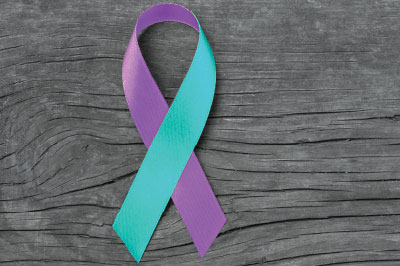Surge in Suicide Prompts Call For Diagnostic Category
Abstract
Advocates argue that suicide-specific diagnoses meet criteria for diagnostic validity and that in the face of an alarming rise in suicide, clinicians and health systems need to do a better job of identifying patients at risk. Opponents cite the risk of stigma and clinician liability.
You are in a large department store late at night without your phone, unaware the store is closing. Suddenly you realize the place has emptied of customers and employees. You find an exit only to realize in a panic that the door is locked—in fact, all of the doors are locked—and you are alone.

And then the lights go out, pitch black.
That’s how one woman described her own state of mind in the period preceding a suicide attempt, a condition of “entrapment and frantic hopelessness,” says clinician and researcher Igor Galynker, M.D., Ph.D., director of the Mount Sinai Beth Israel Suicide Research Laboratory in the Department of Psychiatry at Icahn School of Medicine at Mount Sinai.
Galynker has sought to capture the acute mental state that characterizes the period when an individual may be most at risk for suicide. He has termed this state “suicide crisis syndrome” (SCS) and described features of the syndrome that might be spotted by psychiatrists, other physicians and health care professionals, or even family members and friends—even in the absence of self-reported “suicidal ideation.” Those features include, in addition to “entrapment and frantic helplessness,” affective disturbance, loss of cognitive control, social isolation, and hyperarousal (see story here).
Galynker would like to see the syndrome included as a diagnosis in DSM. “Nothing in medicine is 100%, and there is probably more than one pathway to suicide, but I believe the essential features of suicide crisis syndrome are present in the majority of suicides,” he told Psychiatric News.
He is among a handful of clinician researchers, including Maria A. Oquendo, M.D., Ph.D., past APA president and a director on the National Board of the American Foundation for Suicide Prevention, and Thomas Joyner, Ph.D., director of the Laboratory for the Study and Prevention of Suicide-Related Conditions and Behaviors at Florida State University, who are proposing the inclusion of “suicide-specific diagnoses” to APA’s DSM Steering Committee.
While Galynker’s SCS focuses on symptoms of the acute mental state preceding suicide, Oquendo has proposed a diagnosis of suicidal behavior disorder based on a history of suicidal attempts or behaviors. Joyner has proposed a third diagnosis, acute suicidal affective disturbance, roughly similar to SCS but including as a central component a sudden surge in suicidal intent occurring over the course of minutes, hours, or days.
Opponents of the idea cite stigma and liability concerns. But Galynker, Oquendo, and Joyner argue that in the face of an alarming rise in suicide rates, clinicians and health systems need to do a better job identifying patients at risk. They say specific diagnoses that capture a history of suicidal behavior and/or an acute pre-suicidal mental state can help identify and track patients in need of treatment specifically focused on suicidal thoughts and behaviors, as well as the comorbid psychiatric conditions associated with suicide. And they say that clinicians are already put in jeopardy of liability by having to rely on patients’ self-reports of suicidal ideation.
“Would we rely on patients with schizophrenia or bipolar disorder to diagnose themselves?” Galynker asked in comments to Psychiatric News. “We need a new approach to identifying people at risk that moves away from suicidal ideation and focuses more on acute mental states. An estimated 75% of suicides do not involve suicidal ideation until the immediate period preceding a suicide—or else it is missed or not reported during a clinical encounter.”
Opponents Cite Stigma, Liability
Statistics support the claim that suicide is a national emergency. According to a 2018 report of the Vital Statistics Program of the Centers for Disease Control and Prevention, there were more than 45,000 deaths by suicide in 2016. Between 1999 and 2016, suicide rates rose in every state but one (Nevada) and by more than 30% in half of all 50 states. In eight states (Idaho, Kansas, Minnesota, New Hampshire, North Dakota, South Dakota, Utah, and Vermont), the rate of suicide between 1999 and 2016 rose more than 40%.
At APA’s Annual Meeting in May, Oquendo presented the case for inclusion of suicidal behavior disorder in DSM (Psychiatric News). Echoing Galynker, she said suicidal ideation may never be reported by a patient at risk. The surest predictor of future suicidal behavior is past suicidality, she said; a specific diagnosis based on history of suicidal behavior would flag patients at risk, ensuring they would not be lost in follow-up or during hospital “handoffs,” when patients are transferred between care teams.
She also said suicidal behavior meets criteria for diagnostic validity: it is clinically well described; research has identified postmortem and in vivo laboratory markers; it can be subjected to a strict differential diagnosis; follow-up studies confirm its presence at higher rates in those with a past diagnosis; and it is familial.
And Oquendo said a specific diagnosis based on a history of suicidal behavior would more reliably identify individuals at risk for suicide and associated predictive variables in big-data analyses based on claims data or electronic medical records.

“We are poor predictors, and patients need to hear that we need their help to know when they require enhanced care,” says Hal Wortzel, M.D.
Opponents of suicide-specific diagnoses say there may be better ways to increase alertness to suicide risk than creating diagnoses that will likely result, they say, in both false negatives and false positives.
“Suicide-specific diagnoses aim to be predictive of something that, in fact, we are not very good at predicting,” Hal Wortzel, M.D., co-director of the Suicide Risk Management Consultation Program at the Rocky Mountain MIRECC (Mental Illness Research, Education, and Clinical Center) at the Veterans Administration (VA), told Psychiatric News. “In that sense, there is a more compelling argument for Dr. Oquendo’s historically based diagnosis. But all of the proposals carry with them potentially unintended consequences associated with a diagnosis that may be stigmatizing.”
Wortzel said there is ample clinical experience with patients who have been turned away from treatment in the community because of a history of suicidality. He asked, “What happens to the patient who is discharged with a suicide-specific diagnosis and cannot find an outpatient provider willing to accept the patient into his or her private practice?”
Alternatively, he said, clinician concerns about liability in the face of patient suicide may cause the diagnosis to be used indiscriminately, such that it loses its predictive value. “Clinicians may be inclined to err on the side of caution, applying the diagnosis even when the risk is minimal,” he said. “At that point, the sensitivity and specificity of these diagnoses become problematic and start to undermine the original purpose—to alert clinicians and health care systems to individuals at risk.”
Risk Indicators Already in Use
Wortzel added that in addition to self-reports of ideation, clinicians already routinely take into account the kind of indicators of suicide risk described in the SCS diagnosis. At the same time, he said, he believes it is dangerous to de-emphasize the crucial role of patients’ self-reports. “We are poor predictors, and patients need to hear that we need their help to know when they require enhanced care,” he said.
Wortzel argues instead for standardized systems of risk stratification that would identify and flag patients who should be followed. “At the VA, we emphasize stratifying suicide risk as either acute or chronic and having that clearly delineated in the medical record,” he told Psychiatric News. “A ‘high-risk’ flag can populate a patient’s electronic health record, so that even if the individual travels across the country, clinicians will know to be alert without invoking the potential for diagnostic error of a medical diagnosis.”
Galynker countered that the SCS diagnosis would empower clinical judgment and actually diminish clinician liability associated with relying on patients’ self-reports of suicidal ideation.
Moreover, he said that the urgency of addressing a national epidemic of suicide will only increase and called for widespread education of health care professionals and the public about the features of SCS.
“Suicide rates are increasing, and given the changes in our society, the stressors associated with suicide are not going to diminish,” he told Psychiatric News. “Suicide prevention is a critical problem. In my opinion not only do we need diagnostic criteria, but also we need to make health care professionals aware of the risk factors associated with suicide as a standard part of their education.” ■



